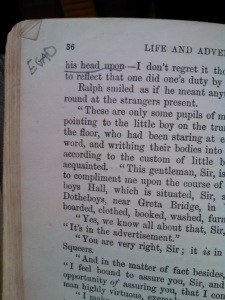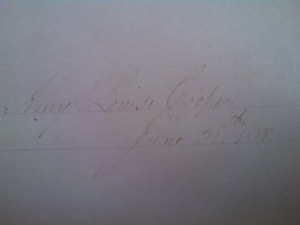When we were given the book traces assignment, I immediately looked for one of my favorite books from the 19th century: The Life and Adventures of Nicholas Nickleby by Charles Dickens.
The edition in Sojourner Truth Library was published by Macmillan in 1907. I have to say, I was disappointed not to find more markings in this incredible book, but one marking I found was some underlining and, beside it in pencil, the word “EGAD.” I am assuming this word is a a direct response to the conditions of Dotheboys Hall in the 1800s. Dotheboys is a fictional boarding school that Charles Dickens created as an example to show the public in a more persuasive way that boarding schools are terrible places to send your children. In this example on pages 35 and 36, Dickens paints a picture using the characters’ discussion of the demise of a young boy who only had a dictionary to lay upon. The reader seems to have had a very personal response to this image. This reader’s response is what Dickens was aiming for in the readers of his generation. Though Nicholas Nickleby is a long novel with many themes and subjects, bringing attention to the insufferable boarding schools of the time was very important to Dickens when writing this book. There are many more examples of the conditions in the boarding schools. Perhaps the novel was too long for the reader to continue, or maybe this statement was the first to really show what occurs in these schools and the reader became less sensitive to the images. Either way, I thought this was an amusing reaction to find out of very few other markings in the text.
In another book, (I regret to say I didn’t document which – likely because there were no other markings), Amy Louise Cooper signed the flyleaf of the book on June 28th, 1888.
The inscription is barely visible now, but it really makes me wonder how far this book has traveled, and whether it has been read entirely, and, if so, how many times it has been read. A quick Google search of Amy Louise Cooper will bring up quite a few people from the past, but, without a sense of geography, there’s no way of knowing which one this book belonged to.
Searching in the library for book traces was a lot of fun, and I will definitely be looking for more in the future. I really enjoy history when I can interact with it, and seeing the words in the handwriting of previous readers makes reading the novel itself so much more satisfying and interesting. The book traces website is fascinating, and I hope I can contribute more book traces as I find them.
-Brooke Chapman


